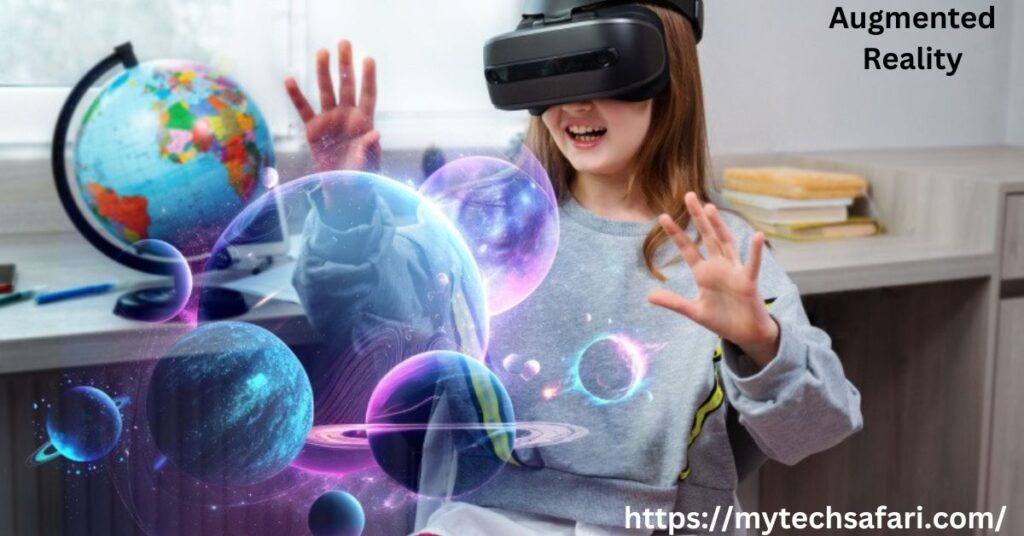In an era where digital technologies are advancing at an unprecedented pace, Augmented Reality (AR) stands as one of the most exciting and transformative innovations. Augmented Reality, often abbreviated as AR, represents the fusion of the physical and digital worlds, offering users a unique and immersive experience that has the potential to revolutionize numerous industries, from gaming and education to healthcare and retail. In this blog post, we will explore the concept of Augmented Reality, its applications, its impact on various sectors, and its future prospects.

Understanding Augmented Reality
Augmented Reality is a technology that superimposes computer-generated information, such as images, sounds, and 3D models, onto a user’s real-world environment. Unlike Virtual Reality (VR), which makes the users to go to a completely digital environment, AR makes the world with digital elements. AR applications can be experienced through various devices, such as smartphones, tablets, smart glasses, and heads-up displays. This technology has the potential to change how we interact with the world around us.
Applications of Augmented Reality
Gaming: One of the most prominent applications of AR is in the gaming industry. Games like Pokémon Go brought AR into the mainstream, allowing players to hunt for virtual creatures in their real surroundings. This concept opened up a new dimension in gaming, making it more interactive and engaging.
Education: AR can revolutionize the way we learn. Educational AR apps can provide interactive and immersive experiences for students. For example, students studying anatomy can use AR apps to visualize 3D models of the human body. This hands-on learning enhances comprehension and retention.
Healthcare: In the field of medicine, AR can assist in surgeries by providing surgeons with real-time information and 3D visualizations of the patient’s anatomy. This can lead to more accurate and less invasive procedures.
Retail: AR is transforming the retail industry by enabling customers to try products virtually. For instance, furniture shoppers can see how a piece of furniture would look in their own living room before making a purchase. This enhances the online shopping experience and reduces returns.
Architecture and Design: Architects and interior designers can use AR to present their designs in a more tangible way. Clients can walk through a virtual representation of a building before it’s constructed, making it easier to make decisions and changes.
Navigation: Augmented reality is changing the way we navigate and explore the world. Apps like Google Maps are incorporating AR features to provide real-time directions by overlaying arrows and labels on the smartphone’s camera view.
The Impact of Augmented Reality on Industries
The adoption of Augmented Reality is significantly impacting various industries, leading to improvements in efficiency, cost-effectiveness, and user experiences.
Entertainment: The gaming industry, as mentioned earlier, has witnessed a major transformation. AR games like “Minecraft Earth” and “Harry Potter: Wizards Unite” offer immersive experiences, attracting millions of players worldwide.
Retail: Augmented Reality is redefining the shopping experience. Retailers can provide virtual fitting rooms, where customers can try on clothes without physically wearing them. This not only reduces the need for physical changing rooms but also enhances customer satisfaction.
Manufacturing and Maintenance: AR is being used in manufacturing to provide workers with real-time information and instructions through smart glasses. This has the potential to improve productivity, reduce errors, and streamline maintenance operations.
Training and Simulation: In sectors such as aviation and military, AR is used for training and simulations. Pilots can practice flying in various conditions, and soldiers can train in realistic virtual environments.
Healthcare: Surgeons are utilizing AR for preoperative planning and during surgery. It allows them to overlay critical information, such as MRI scans, onto the patient’s body, aiding in precision and reducing the risks associated with complex surgeries.
Education: Augmented Reality is making learning more engaging and effective. Students can interact with historical events, explore the solar system, or even dissect virtual animals, all from the comfort of their classrooms.
Future Prospects of Augmented Reality
The future of Augmented Reality looks incredibly promising. Here are some key trends and developments we can expect to see:
Widespread Adoption: As AR hardware becomes more accessible and affordable, we can anticipate its wider adoption across various sectors. Smartphones and AR glasses are likely to be the primary devices for AR experiences.
Improved User Interfaces: User interfaces will continue to evolve to offer more intuitive and immersive experiences. Gesture control, voice recognition, and haptic feedback will become more sophisticated.
Integration with AI: Augmented Reality will be increasingly integrated with Artificial Intelligence (AI), enabling real-time language translation, object recognition, and personalized content recommendations.
5G Connectivity: The rollout of 5G networks will provide faster and more reliable data transfer, which is crucial for seamless AR experiences, especially in real-time applications like video conferencing and gaming.
Healthcare Innovations: AR will continue to transform the healthcare industry, with surgeons performing remote surgeries, medical training becoming more immersive, and patient care becoming more personalized.
Architectural and Urban Planning: City planning and architectural design will benefit from AR, allowing urban planners to visualize proposed changes and improvements to the cityscape.
Education Revolution: As AR applications in education expand, we can expect more interactive and personalized learning experiences, ultimately reshaping the traditional education system.
In conclusion, Augmented Reality is poised to be a revolutionary technology that will redefine how we interact with our world, whether for entertainment, education, or business. Its applications are diverse and continue to expand, with the potential to improve efficiency, reduce costs, and enhance user experiences in various industries. As AR technology evolves and becomes more accessible, the possibilities are endless, and the future is filled with exciting opportunities for innovation and growth. Embracing Augmented Reality means embracing a world where the physical and digital realms seamlessly coexist, offering new dimensions of exploration and engagement.



